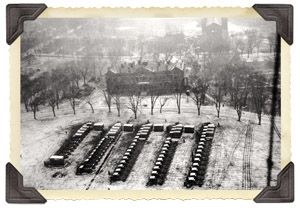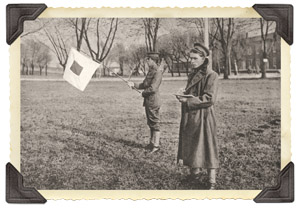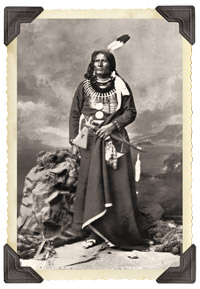Tour Stop A: Parade Ground
As a result of a major confrontation from 1866–1868 between the U.S. Army and the Lakota Sioux, the U.S. government signed the treaty agreeing that the Army would abandon several posts along the Bozeman Trail. By this time, the Union Pacific had also reached the Rockies, so the Army began planning for a single post to replace those abandoned. The new post would be a place where the troops could be wintered and sent out by rail whenever needed.
 Recognizing the potential for economic growth, Omaha competed with other towns to win the planned post. The city cited its railroad and river transportation systems and already established businesses as the support the Army would need. To make the new headquarters possible, civic leaders purchased 42 acres from Augustus Kountze, a prominent Omaha banker, and offered to lease it to the government at an undervalued price.
Recognizing the potential for economic growth, Omaha competed with other towns to win the planned post. The city cited its railroad and river transportation systems and already established businesses as the support the Army would need. To make the new headquarters possible, civic leaders purchased 42 acres from Augustus Kountze, a prominent Omaha banker, and offered to lease it to the government at an undervalued price.
The U.S. Army accepted Omaha's offer. Construction of Omaha Barracks began in September 1868 and was completed in three months. The post housed a regiment of more than 650 men. Following the custom, the main buildings were built around a large parade ground. The first troops arrived in November—Battery C, 3rd U.S. Artillery from Fort Kearney, Neb.
Over the years, brick buildings replaced wooden ones. The Infantry and Cavalry were succeeded by the Army Signal Corps (1905–1913) and the Observation Balloon Corps (1916–1919). During the 1920s and 1930s, the fort was continuously occupied. After 1935, the fort was used as a residence post for officers on duty at 7th Corps area headquarters. During World War II, it served as a support installation for the 7th Service Command.
 In 1947, the Army declared the fort surplus property, and it was taken over by the Navy as a Reserve Training Center. In 1973, the Defense Department again declared Fort Omaha excess to its needs.
In 1947, the Army declared the fort surplus property, and it was taken over by the Navy as a Reserve Training Center. In 1973, the Defense Department again declared Fort Omaha excess to its needs.
Metropolitan Community College, created in 1974, received deed to the property in August 1975. Through extensive interior renovation and exterior refurbishing, Fort Omaha became MCC's first permanent campus. In keeping with tradition, several Army Reserve units currently train here. Terms of the deed stipulate that the Parade Ground must be maintained as an open field and that the exteriors of brick buildings cannot be changed. The College has preserved the historic look of Fort Omaha while creating an environment conductive to a progressive, two-year community college.
Standing Bear Memorial
 In 1877, the U.S. government uprooted the Ponca Indians, forcing their removal from their homeland near the confluence of the Niobrara and Missouri Rivers to Indian Territory (Oklahoma). Nine people died on the journey south, and about 160 people died within months of their arrival in Indian Territory, including Standing Bear's only son, Bear Shield. Bear Shield's dying wish was to be buried in his native land, so Standing Bear and 29 others made the 500-mile journey during the bitter months of winter back to their ancestral lands.
In 1877, the U.S. government uprooted the Ponca Indians, forcing their removal from their homeland near the confluence of the Niobrara and Missouri Rivers to Indian Territory (Oklahoma). Nine people died on the journey south, and about 160 people died within months of their arrival in Indian Territory, including Standing Bear's only son, Bear Shield. Bear Shield's dying wish was to be buried in his native land, so Standing Bear and 29 others made the 500-mile journey during the bitter months of winter back to their ancestral lands.
General George Crook was ordered to arrest the Ponca, but the captor, an Indian sympathizer, set in motion the eventual release of Standing Bear and his followers. While the Ponca were imprisoned at Fort Omaha awaiting their return to Oklahoma, Crook secretly contacted newspaperman Thomas Tibbles. An assistant editor of the Omaha Daily Herald and a one-time minister, Tibbles rallied support for Standing Bear's cause. Through editorials and personal appearances at town churches, Tibbles revealed the Ponca tragedy and gained sympathy for Standing Bear.
Tibbles also enlisted attorneys John L. Webster and A.J. Poppleton to represent Standing Bear and his followers. A writ of habeas corpus was requested in U.S. District Court; the first time such a motion had been filed on behalf of a Native American.
The trial opened in Omaha on April 30, 1879, and lasted two days. A dignified man and eloquent speaker, Standing Bear issued impassioned testimony during the trial. Judge Elmer Dundy's ruling surprised many observers. The judge found that "an Indian is a person within the meaning of the law" and that Standing Bear was being held illegally, thereby granting the writ.
Shortly after the trial, Standing Bear fulfilled his son's wish, burying his bones near the Niobrara River. After years of governmental acts, Standing Bear was granted a parcel of land in the old Ponca territory.
He lived there peacefully with his family, farming and raising livestock until his death in 1908. Honoring Standing Bear's time at the fort and the trial, a memorial stands tribute on the Parade Grounds.
Visit General Crook's Headquarters…